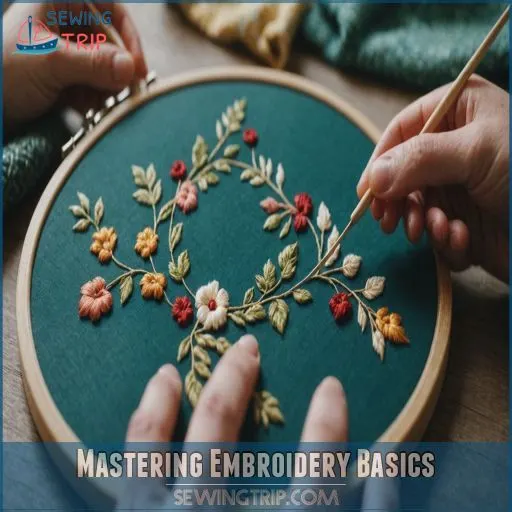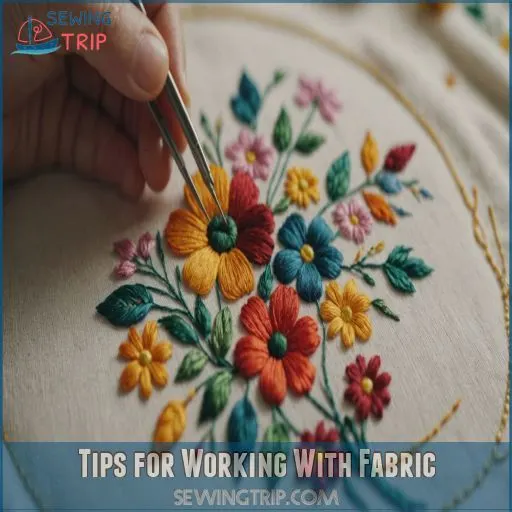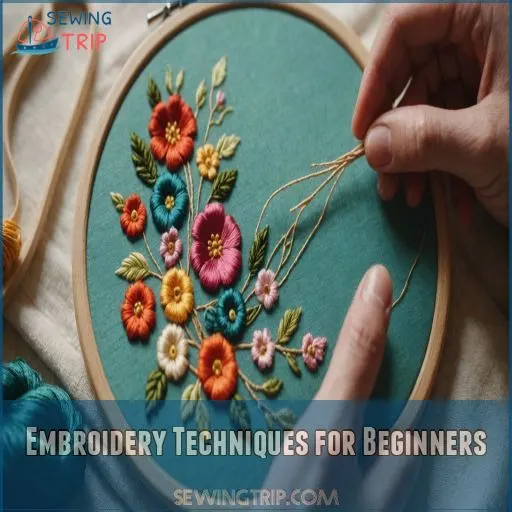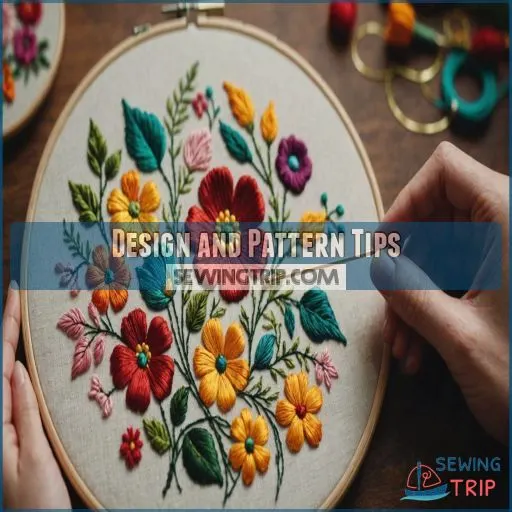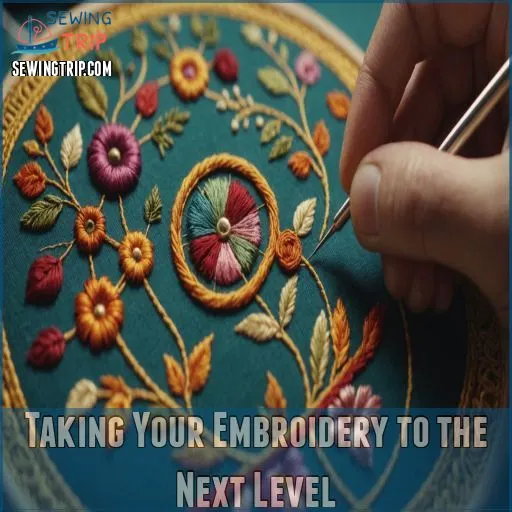This site is supported by our readers. We may earn a commission, at no cost to you, if you purchase through links.
 Ready to level up your embroidery game? You’ve come to the right place for embroidery tips and tricks.
Ready to level up your embroidery game? You’ve come to the right place for embroidery tips and tricks.
Don’t let hoops hold you back – get creative with fabric management. Thread stands can be your secret weapon against feeding woes, while pre-trimming appliqué fabric saves you from close-cutting anxiety.
Experiment with floss thickness and color combos to find your signature style. Remember, embroidery’s all about having fun and expressing yourself.
So, loosen up those shoulders, embrace the occasional wonky stitch, and let your creativity flow. Whether you’re a newbie or a seasoned stitcher, there’s always room to grow.
Curious about the game-changing hack that’ll revolutionize your next project? It’s all about having fun and trying new things, like embracing the occasional wonky stitch.
Table Of Contents
- Key Takeaways
- Mastering Embroidery Basics
- Tips for Working With Fabric
- Thread Management Hacks
- Overcoming Common Embroidery Challenges
- Embroidery Techniques for Beginners
- Design and Pattern Tips
- Stabilizer and Interfacing Solutions
- Time-Saving Tips and Tricks
- Taking Your Embroidery to the Next Level
- Frequently Asked Questions (FAQs)
- Conclusion
Key Takeaways
- You’ll level up your embroidery game by mastering fabric management. Think of your hoop as a drum – keep that fabric taut. And don’t be afraid to get creative with thread stands and pre-trimming appliqué fabric. It’s like giving your project a spa day before the big show.
- Embrace your unique style by experimenting with floss thickness and color combinations. Remember, embroidery’s all about having fun and expressing yourself. So, go ahead, mix those threads like you’re a culinary artist whipping up a colorful masterpiece.
- Don’t let mistakes hold you back – they’re just happy little accidents waiting to become design features. Loosen up those shoulders, take a deep breath, and let your creativity flow. Who knows, that wonky stitch might just become your signature move.
- Keep learning and trying new techniques to take your embroidery to the next level. Whether it’s mastering the stabbing method or diving into free-motion embroidery, you’re on a stitchy adventure. Think of each new skill as a thread in your embroidery toolbox – the more you have, the more intricate and beautiful your creations will be.
Mastering Embroidery Basics
Starting your embroidery journey means getting the right tools and learning some basic stitches.
You’ll soon find that choosing a quality hoop and floss is as important as keeping your snacks hidden from curious pets!
Essential Tools and Supplies for Beginners
Starting your embroidery journey? Begin with the essentials: sharp embroidery needles, high-quality thread, and trusty embroidery scissors.
Choose tight-woven fabric types like linen for a solid start .
A needle minder is your loyal companion, saving you from needle hunts.
Remember, even the smallest supplies can weave stories worthy of your creativity’s grand tapestry.
Choosing the Right Embroidery Hoop for Your Project
Choosing the right embroidery hoop can transform your sewing adventure.
Consider the hoop size and material—opt for sturdy wooden or flexible bamboo for the best fabric tension.
Make sure the hoop has a good grip to keep your design steady. Investigate different hoop styles that suit your project’s needs.
Mastering these embroidery tips ensures cherished results, making your creative endeavors truly satisfying.
Understanding the Importance of High-Quality Embroidery Floss
Picking the perfect hoop sets the stage, but now, let’s chat about embroidery floss and why you’d want high-quality choices. Ever tried floss that splits like a bad hair day? Trust me, you want smooth, durable, and vibrant threads that’ll make your project sing.
- Attractive floss sheen
- Long-lasting floss durability
- Brilliant floss color
- Minimal floss splitting
- Reliable floss brand
Mastering Basic Stitches for Embroidery
Want to conquer embroidery? Mastering basic stitches is key.
The running stitch and backstitch are great starting points, offering versatility in creating lines and patterns.
Practice makes perfect—play with variations and different needle selections to refine your technique.
Explore embroidery patterns and let your creativity run wild, turning simple stitches into beautiful embroidery designs, and happy stitching. Practice makes perfect
Tips for Working With Fabric
Working with fabric in embroidery can feel like wrestling a wiggly octopus, but with the right hacks, you’ll manage it like a pro.
From taming excess fabric to picking the perfect textile, these tips will help your stitching dream not turn into a nightmare, by mastering the right hacks.
Managing Excess Fabric in the Hoop
You’re into embroidery, and managing excess fabric feels like wrestling an octopus.
To keep your project tidy and your sanity intact, try these hacks:
- Use hoop guards to tame stray fabric.
- Secure with fabric clips or rubber bands.
- Roll and pin excess fabric with clothespins.
- Keep fabric tension even by choosing the right hoop size.
Stitch on!
Preventing Fabric From Unrolling During Embroidery
Ever wrestled with fabric tension? Keep fabric snug by using hoop techniques and stabilizer types suited for your project.
Try wrapping excess fabric with thread holders or painter’s tape to prevent unrolling . Clip fabric using clothespins or binder clips, but steer clear of the stitches.
Hoop size matters—pick wisely for hand or machine embroidery magic.
Using the Right Fabric for Your Embroidery Project
Tired of unrolling fabric? Pick the right one to enhance your embroidery. Consider natural fibers and the characteristics of linen or cotton to find your style.
Watch for key factors that will help you choose the perfect fabric for your embroidery project:
- Thread Compatibility: Natural blends often work best.
- Hoop Tension: Go for sturdy materials.
- Stitch Density: Choose heavier fabrics.
- Project Type: Select based on design needs.
And remember: avoid stretchy, flimsy fabrics!
How to Stretch and Secure Fabric in the Hoop
Struggling to keep your fabric taut in the hoop? No worries, we’ve got your back!
Start by loosening the outer hoop just enough to slip the fabric in, then gently pull and adjust until you’ve got that perfect, drum-tight tension.
And remember, don’t overstretch – you want your stitches to stay neat, even when the fabric relaxes. This ensures your work remains neat, even when the fabric is not taut.
Happy hooping!
Thread Management Hacks
Mastering thread management can save you time and frustration, making your embroidery experience much more enjoyable.
You’ll discover handy tricks for smooth thread feeding and controlling stabilizer challenges, so you’re not tangled up in knots!
Using Thread Stands for Smooth Feeding
For smooth thread feeding, using thread stands is a game-changer.
Experience these benefits:
- Types galore: Choose from single or multi-spool stands.
- Easy setup: Keeps threads tangle-free and ready.
- Alternatives: DIY with a cup hook and dowel.
- Sneakiness: Quietly hide that extra floss!
Thread stands: your stitching’s secret weapon!
Preventing Thread Breakage and Tangles
Mastering embroidery requires taming thread breakage and tangles. Make sure your thread tension and hoop tension are just right. Relieve stress by winding bobbins smoothly and using high-quality floss and needles. Imagine your threads dancing gracefully, not a chaotic mess! Strip your threads and let them dangle like free-spirited jump ropes.
| Frustration | Solution | Result |
|---|---|---|
| Tangles | Strip, Hang Threads | Peaceful Stitching |
| Breakage | Superior Needles | Smooth Sailing |
| Frays | Thread Conditioner | Professional Finish |
Happy stitching!
How to Thread Your Embroidery Machine Correctly
Imagine this: your embroidery machine purring like a kitten.
Threading it correctly is the way to get there!
Avoid snarls by:
- Checking your thread tension; it’s like salt—just right is key.
- Winding bobbins with finesse.
- Selecting sharp needles for crisp sewing.
- Understanding your machine types’ quirks.
- Troubleshooting issues proactively to keep creativity flowing.
Using Thread Nets and Slap Bracelets for Stabilizer Control
Tired of stabilizer chaos? Embrace slap bracelets and thread nets for a neat approach!
Wrap slap bracelets around rolled stabilizers for easy storage, and use thread nets to prevent tangles. It’s like giving your embroidery stash a hug!
Check out the table below for quick tips on types and storage:
| Stabilizer Types | Net Benefits |
|---|---|
| Cut-Away | Prevent Tangles |
| Tear-Away | Ergonomic Control |
| Wash-Away | Easy Handling |
| Sticky-Back | Neat Storage |
Overcoming Common Embroidery Challenges
You’ve probably faced a few mishaps while embroidering—don’t worry, it’s completely normal and fixable.
Learn how to tackle common embroidery mistakes, prevent fabric mishaps, and keep your machine running smoothly, so you can enjoy the stitching process without a hitch.
How to Fix Mistakes and Remove Stitches
Oops, you made a mistake? No need to fret – with the right tools and techniques, you can easily fix those pesky embroidery errors.
Carefully snip away any unwanted stitches using small scissors or a seam ripper, then re-stitch the area correctly.
Add a decorative touch to conceal any remaining traces and make your project shine, giving it a professional finish with the right tools.
Preventing Stitching Through Other Parts of Your Garment
Ever stitched and wondered why the back looks like a yarn explosion? It’s all about mastering hooping techniques and fabric tension.
Make sure your stabilizer’s snug against the fabric to stop threads from peeking through.
Layer management is key; use a backing like white cotton to keep stitches invisible.
Choose stitch patterns carefully for perfection.
Troubleshooting Common Embroidery Machine Issues
While you’re mastering stitching without piercing other garment parts, embroidery machine issues like needle breakage or tension snafus might still ruffle your feathers.
If your machine’s bobbin is a rebel or the thread jams, don’t fret.
Make sure your hoop’s snug and check for the right needle. Those quirks are chances to learn and perfect (Source), which can help you overcome needle breakage.
How to Clean Up Your Finished Embroidery
Ready to give your finished embroidery a polished look?
Start by removing excess thread, then trim and secure edges to avoid fraying.
Gently iron and press your piece face-down, using a towel to protect stitches from flattening.
With these finishing touches, your masterpiece is ready for storing or displaying, demonstrating your skill and dedication!
Embroidery Techniques for Beginners
Ready to take your embroidery skills to the next level?
You’re in luck – we’ve got some game-changing techniques that’ll have you stitching like a pro in no time.
From mastering basic stitches to tackling larger designs with ease.
Learning Basic Stitches and Transferring Patterns
Mastering common embroidery challenges sets the stage for your stitching journey.
Let’s explore the building blocks of embroidery: basic stitches and pattern transfer.
You’ll start by learning essential stitches like running stitch and backstitch.
For transferring patterns, try using sulky solvi – a printable, water-soluble sheet that disappears after stitching.
With practice, you’ll be creating beautiful designs in no time. Remember, everyone starts somewhere, so don’t be afraid to make mistakes and enjoy the process of mastering common embroidery challenges.
How to Use a Repositionable Hoop for Larger Designs
Now that you’ve got the basics down, let’s tackle those bigger designs you’ve been eyeing. Repositionable hoops are your secret weapon for expansive embroidery projects.
They allow you to stitch sections of a large design without constantly re-hooping your fabric . Here’s how to make the most of them:
- Imagine your fabric as a canvas, divided into 4×4 inch masterpieces
- Picture yourself as a puzzle master, piecing together your design
- Envision the satisfaction of revealing your completed artwork, section by section
Experimenting With Different Transfer Methods
Embroidery’s beauty lies in its versatility, especially when it comes to pattern transfer methods. You’ve got a buffet of options to choose from!
Let’s explore some popular techniques:
| Method | Pros | Cons | Best For |
|---|---|---|---|
| Water-soluble pen | Easy to use, rinses out | Can smudge | Light fabrics |
| Iron-on transfers | Ready-made designs | Limited customization | Various fabrics |
| Pouncing | Traditional technique | Time-consuming | Intricate designs |
Experiment with these methods to find your perfect match. Remember, it’s all about what feels right in your hands!
Mastering the Stabbing Method of Embroidery
Ready to take your embroidery game up a notch? Let’s explore the stabbing method – a technique that’ll have you stitching like a pro in no time!
This approach is perfect when you’re working with drum-taut fabric in a hoop or frame.
- Makes sure your fabric stays undisturbed
- Less stressful for your thread
- Easier to gauge stitch size and shape
- Results in plumper, more attractive stitches
Design and Pattern Tips
You’re about to discover the secrets of creating stunning embroidery designs that’ll wow everyone who sees them.
From mastering clear transfer marks to splitting larger designs and harnessing the power of embroidery software, these tips and tricks will take your stitching game to a whole new level.
Understanding the Importance of Clear Transfer Marks
Clear transfer marks are the unsung heroes of embroidery success. They’re like a trusty map guiding your needle through uncharted fabric terrain.
Without them, you might end up with wonky stitches or a design that looks more abstract than intended.
Opt for water-erasable pens on light fabrics or Transdoodle chalk for darker materials.
Remember, a crisp, thin line is your best friend in this stitchy adventure.
How to Split Larger Designs Into Smaller Chunks
Splitting larger designs into smaller chunks can open up a world of possibilities for your embroidery projects. Don’t let your machine’s hoop size hold you back!
- Use paper templates to perfectly place each section
- Overlap design elements for a seamless look
- Add lightweight fusible interfacing for stability
With these tricks, you’ll be stitching out bold, beautiful designs in no time, regardless of your hoop size. Size limits? Who needs ’em?
Using Embroidery Software for Design Customization
Get into embroidery software and watch your designs come to life! With powerful tools at your fingertips, you’ll be customizing patterns like a pro in no time.
Check out this handy comparison of popular features:
| Feature | Basic | Advanced |
|---|---|---|
| Design editing | ✓ | ✓ |
| Pattern scaling | ✓ | ✓ |
| Color palettes | ✓ | ✓ |
| Digitizing | – | ✓ |
| Special effects | – | ✓ |
From tweaking existing designs to creating your own masterpieces, embroidery software opens up a whole new dimension of creativity . Ready to unleash your inner artist?
Stabilizer and Interfacing Solutions
Stabilizers and interfacing are the unsung heroes of embroidery, keeping your projects smooth and professional-looking.
You’ll discover how to choose the right stabilizer for your fabric, master heat-away techniques, and troubleshoot common issues that can make even seasoned stitchers want to throw in the towel.
Understanding the Different Types of Stabilizer
Now that you’ve mastered design tips, let’s tackle the backbone of your embroidery: stabilizers. You’ve probably heard whispers about these magical sheets, but what’s the real deal?
Stabilizers come in three main flavors: tear-away, wash-away, and cut-away.
Think of them as your embroidery’s best friend, supporting your fabric and thread to prevent puckering and distortion.
Without the right stabilizer, even the prettiest design can end up looking like a hot mess!
How to Use Heat-Away Stabilizer for Embroidery
Let’s get down to business with heat-away stabilizer, your secret weapon for embroidery success!
This plastic-like film is a game-changer for delicate fabrics and designs with pile.
To use it, hoop your fabric with the rough side of the stabilizer facing down. After stitching, simply tear away excess and zap any remaining bits with a hot, dry iron.
It’s like magic for your embroidery projects, especially with delicate fabrics!
Troubleshooting Common Stabilizer Issues
Stabilizer woes got you down? Don’t throw in the towel just yet!
When gaps appear between fill stitches, you might need to switch up your stabilizer game .
For stretchy fabrics, cut-away stabilizer is your best friend, while tear-away works wonders for heavy wovens.
If you’re battling hoop burn, try floating your project or treating the fabric post-embroidery with a spray of water.
How to Use Interfacing for Added Stability
For a rock-solid foundation in your embroidery, interfacing’s your secret weapon. It’s like a hidden superhero, giving your fabric the strength it needs.
You’ve got options: fusible for a quick iron-on fix, or sew-in for delicate fabrics.
Match the weight to your material – light for silks, heavy for denim. With the right interfacing, you’ll stitch with confidence, knowing your design’s got the backup it deserves.
Time-Saving Tips and Tricks
You’re about to discover time-saving tips and tricks that’ll transform your embroidery game.
These clever hacks will help you streamline your process, stay organized, and tackle projects more efficiently – so you can spend less time fussing and more time creating beautiful designs.
How to Speed Up Your Embroidery Process
Now that you’ve mastered stabilizers, let’s speed up your embroidery process.
Time’s precious, and you want to spend it creating, not fiddling with threads.
Start by having a solid plan before you begin .
Pre-thread multiple needles and use a needle minder to quickly switch colors.
Remember, embroidery’s a slow craft, but these tricks will help you stitch faster without sacrificing quality.
Ready to turbocharge your stitching?
Using Shortcuts and Hacks for Efficiency
Want to stitch faster without compromising quality? Let’s explore some clever shortcuts!
You can use Sulky Sticky+ Stabilizer to quickly hoop and embroider multiple napkins without rehooping.
For needlepainting, skip the traditional row markings and focus on natural stitch variation instead.
And don’t forget to master those go-to stitches like stem stitch and satin stitch for speedy, beautiful results, which will have you embroiderin’ like a pro in no time .
How to Stay Organized and Focused
Embroidery enthusiasts know that staying organized and focused can be as challenging as mastering a French knot.
To keep your embroidery space tidy, consider hanging your floss up . This protects your threads but also helps you find what you need quickly.
Set up a designated workspace and establish stitch goals to maintain focus.
Remember, a well-organized embroiderer is a happy embroiderer!
Prioritizing Your Embroidery Projects
Juggling multiple embroidery projects can feel like spinning plates at a circus.
To keep your creative momentum, prioritize based on project timelines, skill levels, and time commitments.
Create a to-do list and rank tasks nightly . Consider your budget and project size when planning.
Remember, it’s okay to sneak in stitches on passion projects between prioritized items. Your embroidery journey should be fun, not frantic!
Taking Your Embroidery to the Next Level
Ready to take your embroidery skills to new heights?
You’re about to discover game-changing techniques and insider secrets that’ll transform your stitching from amateur to pro-level.
Making your creations stand out and sparkle like never before.
How to Get Really Good at Embroidery
Mastering embroidery is a journey that requires dedication and passion. To truly excel, you’ll need to embrace the process and keep pushing your boundaries.
- Practice relentlessly
- Seek constructive feedback
- Join a supportive community
- Invest in quality resources
Remember, even experienced embroiderers make mistakes . The key is to learn from them and keep stitching. With patience and persistence, you’ll see your work transform into beautiful, professional-quality pieces.
Experimenting With New Techniques and Stitches
A curious embroiderer never stops learning!
To elevate your craft, venture beyond the basics and explore exciting new techniques.
Try free-motion embroidery for a painterly effect, or explore the intricate world of shadow work.
Experiment with satin stitch variations and couching techniques to add depth and texture.
Don’t be afraid to mix things up with needle felting or unconventional materials.
Your creativity is the only limit!
How to Make Your Embroidery Neater and More Professional
Now that you’ve experimented with new stitches, let’s elevate your embroidery game!
To make your work neater and more professional, focus on these key areas:
- Maintain stitch consistency
- Master tension control
- Choose the right needle and thread
- Fix mistakes immediately
Remember, practice makes perfect. Keep your fabric taut in the hoop and develop a method that works for you. With these tips, you’ll be stitching like a pro in no time!
Finishing Touches for Free-Standing Lace Projects
You’ve stitched your free-standing lace project, and now it’s time for those final touches that’ll make it shine!
After soaking and drying your piece , consider adding beads or embellishments for extra sparkle.
Attach findings like clasps or hooks if you’re making jewelry. For a professional finish, block your lace to shape it perfectly.
Remember, these finishing steps can turn your project from good to jaw-dropping. Ready to make your lace the talk of the town?
Frequently Asked Questions (FAQs)
Is machine embroidery difficult for beginners?
Diving into machine embroidery can feel like threading a needle in the dark, but it’s not as intimidating as it seems.
You’ll face a learning curve with equipment and techniques, but with patience and practice, you’ll be stitching masterpieces in no time.
How can I Make my embroidery look better?
To make your embroidery shine, loosen up those stitches!
Tight pulls can pucker fabric.
Practice regularly, embrace mistakes as learning opportunities, and consider taking an online course for expert guidance.
Remember, it’s all about having fun!
How do I learn embroidery?
Ready to learn the art of embroidery?
Start with the basics: gather essential supplies like needles, fabric, and threads (Source).
Then, get started with simple stitches like backstitch and satin stitch.
Practice makes perfect, so don’t be afraid to experiment!
What’s a good topic to learn about embroidery?
You’ll love learning about running stitch – it’s the perfect beginner’s technique.
It’s simple, versatile, and creates beautiful designs.
You’ll only need basic supplies like an embroidery hoop, fabric, thread, and scissors to get started.
How to get really good at embroidery?
Practice consistently and experiment with different techniques. Invest in quality supplies, including a reliable embroidery machine and stabilizers.
Join online communities to learn from experts, and take classes to master foundational skills.
Don’t be afraid to make mistakes and learn from them.
How do I make my embroidery neater?
Like untangling a ball of yarn, neatening your embroidery takes patience.
Keep your fabric taut in a hoop and mind your tension – not too loose, not too tight (Source).
Choose the right needle size and thread count.
How do you neatly finish embroidery?
Trim your fabric, leaving about an inch around the hoop . Fold edges neatly and secure with running stitch.
Iron out pen marks , gently wash if needed, and consider framing for a polished look .
What is the stabbing method of embroidery?
The stabbing method involves pushing your needle through the fabric from front to back, then back to front for each stitch.
It’s great for taut fabric in hoops or frames, ensuring neat, consistent stitches.
Give it a try!
How to transfer designs for large, complex projects?
For large, complex embroidery projects, you’ll want to use a lightbox or LightPad .
It’s a game-changer!
Stretch your fabric taut, align it with the grain, and trace your design carefully.
Don’t forget to leave ample space around the edges.
Which printable transfer papers work best for embroidery?
Holy thread, Batman! You’re in for a wild ride with printable transfer papers!
For embroidery wizardry, water-erasable pens are your magic wand. They’re simple, cheap, and vanish like a ghost when you’re done.
No more pattern-tracing nightmares!
Are Frixion pens suitable for embroidery design transfer?
Frixion pens can be a double-edged sword for embroidery transfers.
They’re erasable with heat, which is handy, but beware – the marks can reappear in cold temperatures.
Always test on scrap fabric first.
Whats the prick and pounce method for design transfer?
Prick and pounce is a traditional embroidery transfer technique.
You’ll prick tiny holes along your design, then dust chalk powder over it.
The powder seeps through, creating a dotted outline on your fabric. It’s like magic!
How to choose the right thread for string art?
Picture a spider spinning its web – that’s you choosing thread for string art!
You’ll want to weave magic with the right material.
Consider durability, color, and thickness.
Cotton’s a champ, but don’t shy away from acrylics or metallics for pizzazz.
Conclusion
Ready to elevate your embroidery game? Armed with these embroidery tips and tricks, you’re set to create stunning designs with confidence.
Remember, practice makes perfect, so don’t be afraid to experiment and embrace those occasional wonky stitches. They’re part of your unique style!
Keep exploring new techniques, stay patient, and most importantly, have fun. Whether you’re stitching for relaxation or pursuing a passion project, these hacks will help you master your craft.
So grab your hoop, thread that needle, and let your creativity soar!

